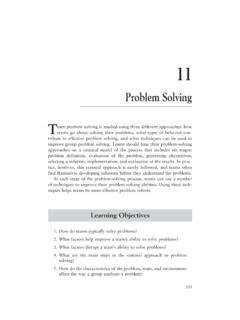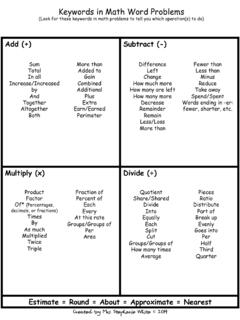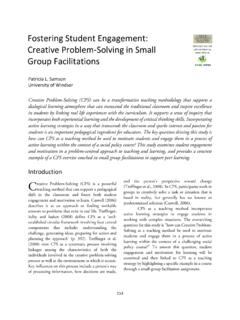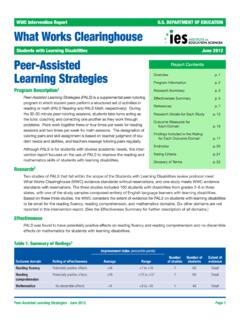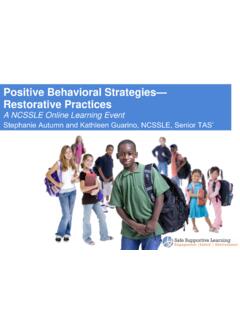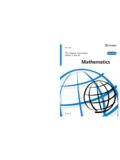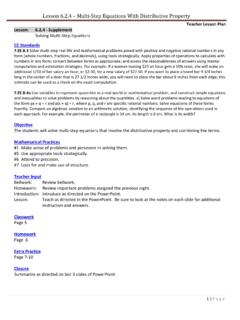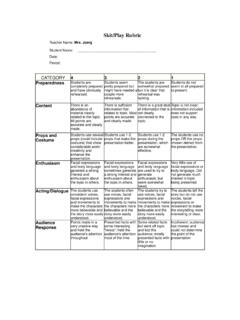Transcription of MATHEMATICAL PROBLEM-SOLVING STRATEGIES AMONG …
1 53 Guzman Gurat M. - ERIES Journal vol. 11 no. 3 Printed ISSN: 2336-2375 Guzman Gurat M. (2018) MATHEMATICAL PROBLEM-SOLVING STRATEGIES AMONG student teachers , Journal on Efficiency and Responsibility in Education and Science, Vol. 11, No. 3, pp. 53-64, online ISSN 1803-1617, printed ISSN 2336-2375, doi: PROBLEM-SOLVING STRATEGIES AMONG STUDENT TEACHERS AbstractThe main purpose of the study is to understand the MATHEMATICAL PROBLEM-SOLVING STRATEGIES AMONG student teachers. This study used both quantitative and qualitative type of research.
2 Aside from the semi-structured interviews, data were gathered through participant s actual MATHEMATICAL PROBLEM-SOLVING outputs and the videotaped interviews. Findings revealed that the PROBLEM-SOLVING STRATEGIES AMONG student teachers in the PROBLEM-SOLVING subject are cognitive, metacognitive and other STRATEGIES . The cognitive STRATEGIES used by the student teachers are rehearsal, elaboration, and organization. The metacognitive STRATEGIES are critical thinking and self-regulation. Other STRATEGIES are overlapping the cognitive and metacognitive STRATEGIES .
3 These are prediction/orientation, planning, monitoring, and evaluating. The findings also suggest significant influence of the STRATEGIES on the academic performance of the student , critical thinking, elaboration, metacognitive, organization, rehearsal, self-regulationMelanie Guzman GuratSchool of Teacher Education and Humanities / School of Graduate Studies, University Research Center, Saint Mary s University, PROBLEM-SOLVING STRATEGIES AMONG student teachers are cognitive, metacognitive and other STRATEGIES Results indicate significant influence of the STRATEGIES on academic performance of the student teachersArticle typeFull research paperArticle historyReceived: September 14, 2017 Received in revised form: August 29, 2018 Accepted: August 29, 2018 Available on-line: September 30, 2018 IntroductionProblem- solving has a special importance in the study of mathematics (Wilson, Fernandez and Hadaway, 2011).
4 The main goal in teaching MATHEMATICAL PROBLEM-SOLVING is for the students to develop a generic ability in solving real-life problems and to apply mathematics in real life situations. It can also be used, as a teaching method, for a deeper understanding of concepts. Successful MATHEMATICAL PROBLEM-SOLVING depends upon many factors and skills with different characteristics. One of the main difficulties in learning PROBLEM-SOLVING is the fact that many skills are needed for a learner to be an effective problem solver.
5 Also, these factors and skills make the teaching of PROBLEM-SOLVING one of the most complex topics to teach (Dendane, 2009). Mathematics is used to quantify numerically and spatially natural as well as man-made situations. It is used to solve problems and it has helped in making social, economic and technological advances (Dendane, 2009).Learning facts and contents in mathematics are important but these are not enough. Students should learn how to use these facts to develop their thinking skills in solving problems.
6 Special attention for the development of PROBLEM-SOLVING ability has been accepted by mathematics educators (Stanic and Kilpatrick, 1989) and genuine MATHEMATICAL PROBLEM-SOLVING is one of the most important components in any mathematics program or curriculum (Stacey, 2005; Halmos, 1980; Cockcroft, 1982). MATHEMATICAL PROBLEM-SOLVING may help students to improve and develop the standard ability to solve real-life problems, (Reys et al. 2001), to develop critical thinking skills and reasoning, to gain deep understanding of concepts (Schoenfeld, 1992; Schoen and Charles, 2003) and to work in groups, cooperate with and interact with each other (Dendane, 2009).
7 Specifically, it may also improve eagerness of an individual to try to analyze MATHEMATICAL problems and to improve their determination and self-concepts with respect to the abilities to solve problems; make the individual aware of the PROBLEM-SOLVING STRATEGIES , value of approaching problems in an orderly manner and that many problems can be solved in more than one way and; improve individuals abilities to select appropriate solution STRATEGIES , capacity to implement solution STRATEGIES accurately and abilities to get a correct answers to problems (Hoon, Kee, and Singh, 2013).
8 A heuristic is a MATHEMATICAL PROBLEM-SOLVING strategy formulated in a free-of-context manner and done systematically (Koichu, Berman and Moore, 2004). Moreover, a heuristic approach can encourage connection of MATHEMATICAL thoughts by examining special cases, drawing a diagram, specializing the solution, generalizing the solution (Hoon, Kee, and Singh, 2013). It is associated with non-routine MATHEMATICAL problems such as looking backward or thinking forward (Koichu, Berman and Moore, 2004).
9 Several studies were conducted to improve students skills in solving mathematics problems. Hoon, Kee, Singh (2013) investigated students response in applying heuristics approach in solving MATHEMATICAL tasks, and their abilities in applying the heuristics approach. Reiss and Renkl (2002) proposed the use of heuristic worked-out examples in proving. They suggested that this should be integrated into mathematics classroom frequently so that students will learn to extract needed information in the problems.
10 Novotn (2014) aimed to improve the pupils culture of PROBLEM-SOLVING through dealing with STRATEGIES such as analogy, guess-check-revise, problem reformulation, solution drawing, systematic experimentation, way back and use of graphs of functions With the studies showing how STRATEGIES can improve mathematics problem solving , Koichu, Berman, and Moore (2004) aimed to promote heuristic literacy in a regular mathematics , Dewey s (1933) How we think , Polya s (1988) PROBLEM-SOLVING methods and the stages of Krulik and 5455 Guzman Gurat M.










